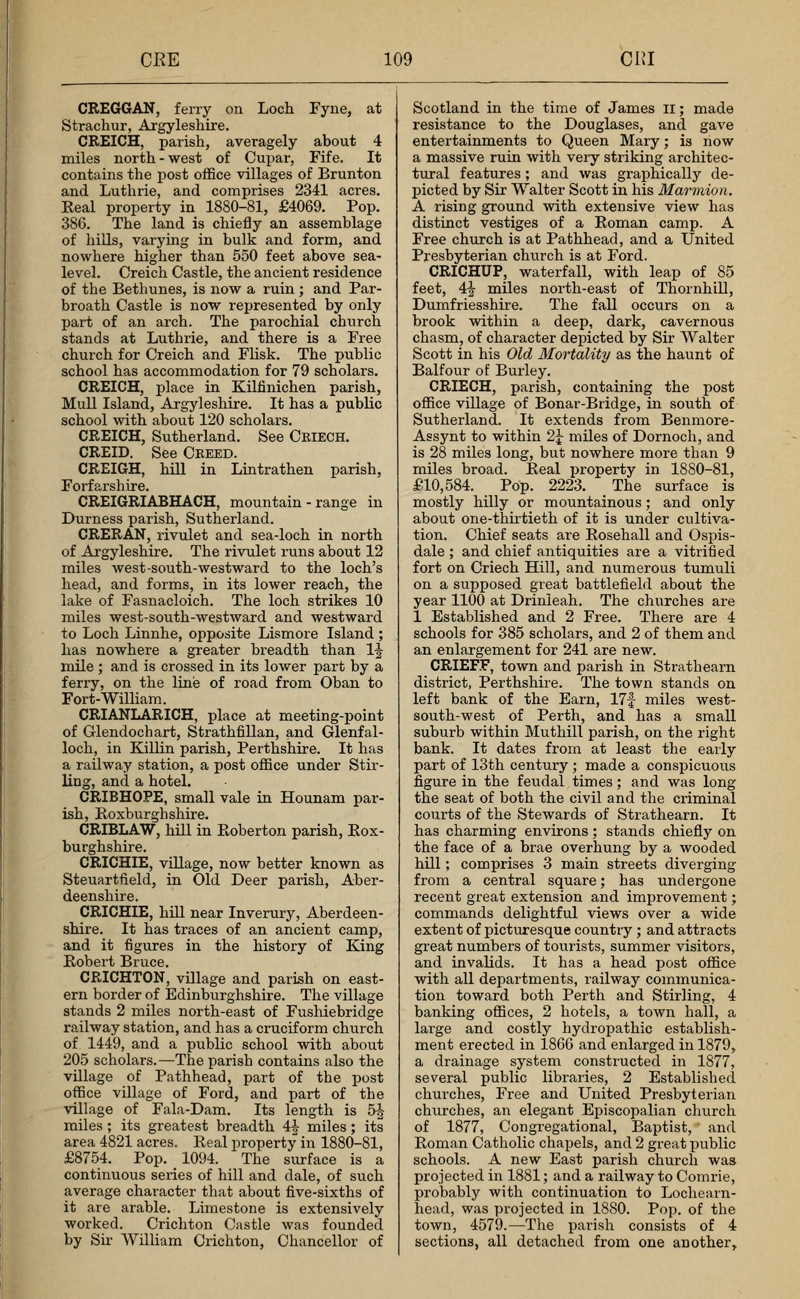CREGGAN, ferry on Loch Fyne, at Strachur, Argyleshire.
CREICH, parish, averagely about 4 miles north-west of Cupar, Fife. It contains the post office villages of Brunton and Luthrie, and comprises 2341 acres. Real property in 1880-81, 4069. Pop. 386. The land is chiefly an assemblage of hills, varying in bulk and form, and nowhere higher than 550 feet above sea-leveL Creich Castle, the ancient residence of the Bethunes, is now a ruin ; and Parbroath Castle is now represented by only part of an arch. The parochial church stands at Luthrie, and there is a Free church for Creich and Flisk. The public school has accommodation for 79 scholars.
CREICH, place in Kilfinichen parish, Mull Island, Argyleshire. It has a public school with about 120 scholars.
CREICH, Sutherland.
CREID.
CREIGH, hill in Lintrathen parish, Forfarshire.
CREIGRIABHACH, mountain-range in Durness parish, Sutherland.
CRERAN, rivulet and sea-loch in north of Argyleshire. The rivulet runs about 12 miles west-south-westward to the loch's head, and forms, in its lower reach, the lake of Fasnacloich. The loch strikes 10 miles west-south-westward and westward to Loch Linnhe, opposite Lismore Island ; has nowhere a greater breadth than 1^ mile ; and is crossed in its lower part by a ferry, on the line of road from Oban to Fort-William.
CRIANLARICH, place at meeting-point of Glendochart, Strathfillan, and Glenfalloch, in Killin parish, Perthshire. It has a railway station, a post office under Stirling, and a hotel
CRIBHOPE, small vale in Hounam parish, Roxburghshire.
CRIBLAW, hill in Roberton parish, Roxburghshire.
CRICHIE, village, now better known as Steuartfield, in Old Deer parish, Aberdeenshire.
CRICHIE, hill near Inverury, Aberdeenshire. It has traces of an ancient camp, and it figures in the history of King Robert Bruce.
CRICHTON, village and parish on eastern border of Edinburghshire. The village stands 2 miles north-east of Fushiebridge railway station, and has a cruciform church of 1449, and a public school with about 205 scholars. The parish contains also the village of Pathhead, part of the post office village of Ford, and part of the village of Fala-Dam. Its length is 5^ miles ; its greatest breadth 4i miles ; its area 4821 acres. Real property in 1880-81, 8754. Pop. 1094. The surface is a continuous series of hill and dale, of such average character that about five-sixths of it are arable. Limestone is extensively worked. Crichton Castle was founded by Sir William Crichton, Chancellor of Scotland in the time of James n ; made resistance to the Douglases, and gave entertainments to Queen Mary ; is now a massive ruin with very striking architectural features ; and was graphically depicted by Sir Walter Scott in his Marmion. A rising ground with extensive view has distinct vestiges of a Roman camp. A Free church is at Pathhead, and a United Presbyterian church is at Ford.
CRICHUP, waterfall, with leap of 85 feet, 4J miles north-east of Thornhill, Dumfriesshire. The fall occurs on a brook within a deep, dark, cavernous chasm, of character depicted by Sir Walter Scott in his Old Mortality as the haunt of Balfour of Burley.
CRIECH, parish, containing the post office village of Bonar-Bridge, in south of Sutherland. It extends from Benmore-Assynt to within 2 miles of Dornoch, and is 28 miles long, but nowhere more than 9 miles broad. Real property in 18SO81, 10,584. Pop. 2223. The surface is mostly hilly or mountainous ; and only about one-thirtieth of it is under cultivation. Chief seats are Rosehall and Ospisdale ; and chief antiquities are a vitrified fort on Criech Hill, and numerous tumuli on a supposed great battlefield about the year 1100 at Drinleah. The churches are 1 Established and 2 Free. There are 4 schools for 385 scholars, and 2 of them and an enlargement for 241 are new.
CRIEFF, town and parish in Strathearn district, Perthshire. The town stands on left bank of the Earn, 17| miles west-south-west of Perth, and has a small suburb within Muthill parish, on the right bank. It dates from at least the early part of 13th century ; made a conspicuous figure in the feudal times ; and was long the seat of both the civil and the criminal courts of the Stewards of Strathearn. It has charming environs ; stands chiefly on the face of a brae overhung by a wooded hill ; comprises 3 main streets diverging from a central square; has undergone recent great extension and improvement ; commands delightful views over a wide extent of picturesque country ; and attracts great numbers of tourists, summer visitors, and invalids. It has a head post office with all departments, railway communication toward both Perth and Stirling, 4 banking offices, 2 hotels, a town hall, a large and costly hydropathic establishment erected in 1866 and enlarged in 1879, a drainage system constructed in 1>77. several public libraries, 2 Established churches, Free and United Presbyterian churches, an elegant Episcopalian church of 1877, Congregational, Baptist, ;\ml Roman Catholic chapels, and 2 great public schools. A new East parish church was projected in 1881 ; and a railway to Comrie, probably with continuation to Lochearnhead, was projected in 1S80. Pop. of the town, 4579. The parish consists of 4 sections, all detached from one another, and comprises 20,385 acres. Real property in 1880-81, 29,805. Pop., quoad civiha, 4852 ; quoad sacra, 2864. The section containing the town measures about 4 miles by 3, contains no higher ground than the wooded hill called the Knock of Crieff, and exhibits the beauty and luxuriance which so extensively prevail on the low grounds of Strathearn. Two other sections, Callander and Achalhanzie, lie in the low country, but are of small extent. The fourth section, comprising Corriemucklock and the greater part of Glenalmond, lies north of Monzie parish, and is mostly highland, or even alpine, romantic, and wild. Both the seats and the interesting natural objects are numerous. 4 schools for 848 scholars are in the parish, and an enlargement of 1 of them for 345 is new.

